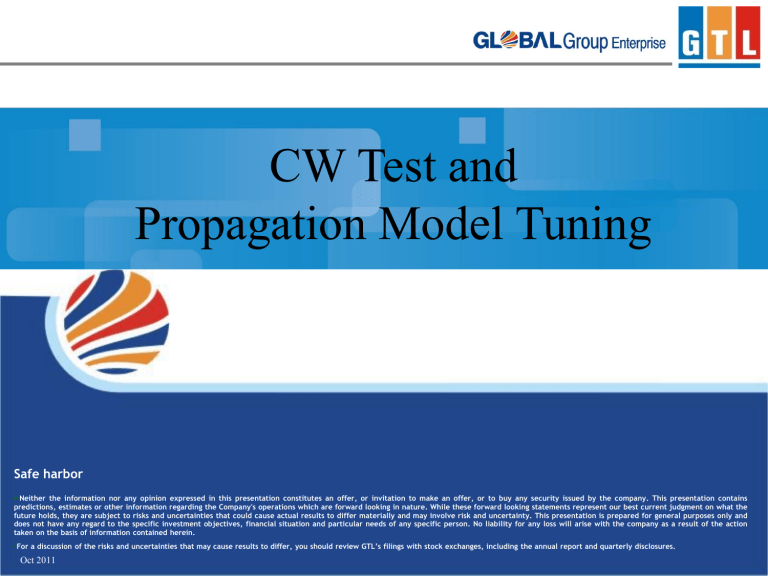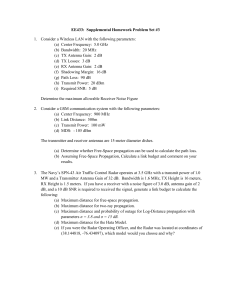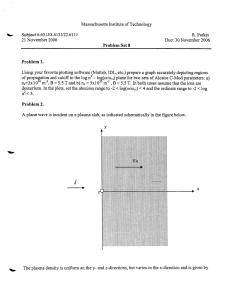
CW Test and Propagation Model Tuning Safe harbor • Neither the information nor any opinion expressed in this presentation constitutes an offer, or invitation to make an offer, or to buy any security issued by the company. This presentation contains predictions, estimates or other information regarding the Company's operations which are forward looking in nature. While these forward looking statements represent our best current judgment on what the future holds, they are subject to risks and uncertainties that could cause actual results to differ materially and may involve risk and uncertainty. This presentation is prepared for general purposes only and does not have any regard to the specific investment objectives, financial situation and particular needs of any specific person. No liability for any loss will arise with the company as a result of the action taken on the basis of information contained herein. •For a discussion of the risks and uncertainties that may cause results to differ, you should review GTL’s filings with stock exchanges, including the annual report and quarterly disclosures. Oct 2011 Introduction CW test (Continuous Wave test) is an important step of Propagation Model Tuning. According to the CW test data (including latitude / longitude and received signal level) and corresponding Digital maps, we can get the accurate Propagation Model through tuning. Objectives Know principle of propagation model tuning Know the procedure of CW test Know the procedure of tuning propagation model Contents 1 Principle of Model Tuning 2 CW Test Flow 3 Pre-processing of CW Test Data 4 Propagation Model Tuning Radio Propagation Model Propagation model is used to predict the effect of terrain, obstacle and artificial environment on the path loss. WCDMA common propagation models Common Radio Propagation Models Based on Statistics Based on theory analyses Okumura/Hata model Ray Tracing model For: 900M-1500MHz COST231-Hata model For: 1500-2000MHz COST231 Walfish-Ikegami model For: 800M-2000MHz Keenan-Motley model For indoor propagation SPM model in U-Net For macro cell on 300M-2000M Volcano model WaveSight model WinProp model Radio Propagation Model in Atoll SPM model (Standard Propagation Model): PathLoss = K1 + K2log(d) + K3log(HTxeff) + K4*Diffraction loss + K5log(d)×log(HTxeff) + K6*(HRxeff) + Kclutter*f(clutter) K1: constant (dB) K2: multiplier factor of log(d) d: distance between Tx antenna and Rx antenna (m) K3: multiplier factor of log(HTxeff) HTxeff: effective height of Tx antenna (m) K4: multiplier factor of diffraction loss, which must be a positive number Diffraction loss: diffraction loss through the path with barriers (dB) K5: multiplier factor of log(HTxeff)log(d) K6: multiplier factor of HRxeff HRxeff: effective height of Rx antenna (m) Kclutter: multiplier factor of for f(clutter) f(clutter): average weighted loss caused by clutter With a set of K parameter, we can make prediction for the planning area. Typical Radio Propagation Environment Name DenseUrban Urban Sub-Urban Description Therearedensebuildingsinthecity,normallymostofthe buildingsaremorethan10floorshigh. Normalareaincities.Buildingsarenotsodense.Normally therearestreetsorplantingareasbetweenthem.Andfew buildingsaremorethan10floorshigh. Buildingsaresparselydistributed,andmainlylowbuildings. Country Village.Buildingsaredistributedverysparsely,andmainly houses. Special Includingmountainarea,seasurface,highway,indoor, tunnel,etc. Different radio scenario adopts different propagation model. Principle of Propagation Model Tuning Target Propagation Environment Setup a Model Collect data from field test Set the model Parameter Actual PathLoss Prediction PathLoss Compare Meet the precision request? Y End N Propagation Model Tuning working flow 1. Decide the propagation environment 2. Acquire site, setup the simulation site, transmitting continuous wave (CW) signal 3. Drive test on the pre-planned route, collecting enough data 4. Post process the data, compare test results with prediction results, and then tune the propagation parameters (K1, K2, …Kclutter) GPS Satellite Basic Principle of CW Test Typification The CW test data must represent the characteristic of electromagnetic wave in this area. Balance The CW test data must represent the characteristic of electromagnetic wave by the proportion of different clutters in this area. Contents 1 Principle of Model Tuning 2 CW Test Flow 3 Pre-processing of CW Test Data 4 Propagation Model Tuning Contents 2 CW Test Flow 2.1 Decide the Propagation Environment 2.2 Site Selection 2.3 Setup Test Platform 2.4 Plan the Drive Test Route 2.5 Drive Test 2.1 Decide the Propagation Environment Firstly, decide if it’s necessary to separate the planning area to several propagation environments, such as Dense Urban, Urban, Sub-Urban or Rural Area, etc. Then for each environment, set proper initial propagation model parameter, and perform dedicate CW test and propagation model tuning. 2.2 Site Selection – Principles Number of sites: It is usually agreed that a minimum of 5 sites should be tested in large and dense city, and one site is enough for normal city, which mainly depends on antenna height and EIRP. Representation: Site selection should aim to cover all types of clutter (from the digital map) in the coverage zone. Multiple models: Define the corresponding zone of each model if the test environment requires multiple models to describe its propagation characteristics. Overlap: Increase measurement overlap area between each site as much as possible. But reasonable inter-site distance should be ensured. Obstacle: The data should be filtered in the subsequent processing if obvious obstacle exists. 2.2 Site Selection – Standards 1. Antenna height of the CW transmitter should be greater than 20m. 2. Antenna of the CW transmitter should be at least 5m higher than the obstacle objects nearby within 50m far. 5m Note: Here the obstacle mainly refers to the highest building on the rooftop where the antenna is installed. The building where the site is located should be higher than average height of surrounding buildings. 2.3 Setup Test Platform (1) CW Transmitter: Tx antenna, feeder, RF signal source and antenna pole CW Receiver: test receiver, GPS receiver, test software and laptop Tx antenna RF Signal Source RF cable 1 CW Transmitter Power Booster Power supply RF cable 2 Rx antenna Drive test tool (GPS Build-in) CW Receiver Laptop 2.3 Setup Test Platform (2) TX Antenna CW Transmitter CW Receiver Mobility Power Supplier 2.3 Setup Test Platform (3) Record the gain or loss of all the RF parts: a) TX power of the CW transmitter b) Loss of the RF cables c) Gain of TX antenna d) Loss of the connectors e) Gain of Rx antenna Then with a, b, c and d, we can get the EIRP. 2.4 Plan the Drive Test route (1) Rules to plan the route Landform: The route must cover all main landforms in the area. Height: The test route must cover landforms with different height in this area if the landforms are up-and-down. Distance: The route must cover near and far to the site. But normally no need to test in areas more than 2R far away to the site. – R: Future cell radius in this area. Direction: The route must be consistent on the horizontal and vertical route. Length: The total distance of one CW test route should be longer than 60km. Number of test samples: The more, the better. (At least 10,000 samples, and at least 4 hours test time) 2.4 Plan the Drive Test route (2) Rules to plan the route Overlap: Overlap the test route in different sites as much as possible to enhance the reliability of models. Obstacle: Shadow areas behind walls should be avoided when antenna signals are obstructed by the wall. Such areas as under viaducts or in tunnels should be avoided. If have to pass through such areas, data should be filtered after test. If a directional antenna is adopted for a CW transmitter, the test route should be planned within the main lobe coverage area of the antenna (don’t plan route in area behind the antenna). 2.5 CW Drive Test – Limitation of the speed CW drive test data contains results affected by slow fading (shadow fading) and fast fading (Raileigh Fading). To tune a model, only the effect by slow fading will be accept, but not fast fading. To get rid of the effect caused by fast fading, enough samples are need in a certain distance. Lee criteria says the request for sampling: At least 50 samples on 40λ range, then the difference between mean value of test data and actual value can be less than 1dB – λ: wavelength of the RF signal Then the maximum vehicle speed: Vmax= 0.8λ*f – f: samples per second of the receiver 2.5 CW Drive Test - Equipment Scanner – DTI (GPS build in) GPS antenna RF antenna of scanner Cables for data and power Laptop Probe and Dongle Contents 1 Principle of Model Tuning 2 CW Test Flow 3 Pre-processing of CW Test Data 4 Propagation Model Tuning Contents 3 Pre-processing of CW Test Data 2.1 Data Filtering 3.2 Data Dispersion 3.3 Data Binning 3.4 Format Conversion 3.1 Data Filtering Six kinds of data should be filtered: 1. Data tested in places where GPS is unable to locate accurately (such as under the viaduct, in the tunnel) 2. Data obtained when the distance to antenna is too near or too far 3. Data obtained with too weak signals 4. Error data caused by inexact antenna pattern 5. Data with a loss exceed over 15~30 dB but no reasonable reason 6. Other data inconsistent with the requirements during the route planning of CW test 3.2 Data Dispersion (1) Principle: Sampling speed of the receiver is much more higher than that of the GPS. So there are many receiver samples stored together on each GPS sample. Actually these receiver samples should be distributed one by one in time sequence between every two GPS samples. Between two GPS sample, vehicle speed is regarded uniform, so the time intervals between every two adjacent receiver samples are same. 3.2 Data Dispersion (2) Data Process: Equally distribute the receiver samples to the route section between two GPS points in time sequence so that there will be sufficient points in every 40λ range on test route. 3.3 Data Binning (1) Objective: Keep the impact of slow fading but eliminate the fast fading According to Lee criteria: At least 50 samples on 40λ range, then the error between the mean value of the data on this 40λ range and the actual value can be less than 1dB. Methods: Method 1 (Grid Binning): Divide the whole area into 40λ*40λ grids, take the average value for data located in each grid, and take the center of each grid as the new location. 3.3 Data Binning (2) Methods: Method 1 (Grid Binning): Divide the whole area into 40λ*40λ grids, take the average value for data located in each grid, and take the center of each grid as the new location. Method 2 (Distance Binning): Divide the drive test route into sections with 40λ length, take the average value for data located on each section, and take the center of each section as the new location. 40λ Tool: TEMS Investigation, or CW Data Editor 3.4 Format Conversion The data exported by TEMS is a .txt file with format: X (Longitude) Y (Latitude) Power (dBm) Data imported to Atoll is a .dat file Format conversion can be implemented manually (save as .dat file) Contents 1 Principle of Model Tuning 2 CW Test Flow 3 Pre-processing of CW Test Data 4 Propagation Model Tuning Contents 4 Propagation Model Tuning 4.1 Basic Knowledge 4.2 Model Tuning by U-Net Procedure of Model Tuning CW data SPM Model Set Model Parameter Perform Appropriate Filtering SPM Calibration YES NO Is Filtering Necessary Analysis Results NO Goto Next Parameter Error Satisfactorily Low? YES Original Data is Unreasonable. Need to retest. All Parameters finished Calibration? YES End NO Criteria to evaluate the model (1) The main idea to evaluate the model is to compare the predicted value to the actual test value for a certain area, then get a statistics result of the errors. Suppose the error of sample E(i) [dB] i is: Ppredicted P measured [dBm] [dBm] Criteria to evaluate the model (2) Mean Deviation RMS Deviation Standard Deviation Correlation Coefficient Corr.Coeff . E 1 n Ei dB n i 1dB ERMS 1 n E2i dB n i1 dB 1 E dB n1 ((P (P Ei E i 1 dB dB 2 n measured measured (i)Pmeasured).(P Predecited(i)P predicted)) (i)Pmeasured) .(P Predecited(i)P predicted)2 2 Criteria to evaluate the model (3) A model is reasonable if the statistics of the error between the predicted results and the actual results meet the following requests: Mean Deviation 2dB E 2dB Standard Deviation 8dB Correlation Coefficient Corr.Coeff .0.8 Contents 4 Propagation Model Tuning 4.1 Basic Knowledge 4.2 Model Tuning by U-Net 4.2.1 Establish a Project 4.2.2 Establish a Propagation Model 4.2.3 Create the Transmitter 4.2.4 Import the CW test data & Digital Map correction 4.2.5 CW data Filtering 4.2.6 Implement the Tuning 4.2.7 Evaluate the Turned Model Model Tuning Operation flow on Atoll 4.2.1 Establish a Project for Model Tuning Create a new project Select ―UMTS‖ in the dialog of ―Project type‖ selection Set the coordinate system Set the coordinate system according to the digital map. ―WGS84 UTM Zones‖ is widely used. Import digital map Import antenna pattern data 4.2.2 Establish a Model to be turned (1) Create a new SPM model by duplicate Create a new ―copy of standard propagation model‖ by duplicating on a exist ―standard propagation model‖. Then rename is if necessary. Set initial parameters for the new model General Parameter Common Parameter – Select the effective antenna height. – Select calculation method of diffraction loss Clutter Parameter 4.2.2 Establish a Model to be turned (2) Initial K parameters of SPM model in normal Urban city Frequency(MHz) 450 900 935 1805 2110 K1 4.3 12.1 12.6 22 24.3 K2 44.9 K3 5.83 K4 0.5 K5 -6.55 K6 0 4.2.3 Create the CW Transmitter Two way to create CW transmitter: By head file —— Suitable for batch importing the transmitters Head file is a text file with extension name .hd, it contains basic information for a CW transmitter e.g.:test.dat DATE test 741790 32 54 0 0 0 23.04499751 113.7509966 Survey 0 GPS 0 0 0 0 hard Be aware to import the antenna before the head file Be aware to import the CW data manually after the head file Manually create —— It is more flexible for single CW transmitter As normal U-Net project, one by one set the antenna, site and transmitter, etc. Pay attention to the latitude and longitude, EIRP, all the feeder loss and connecter loss. 4.2.4 Import the CW data Pre-process on the CW test data For model tuning, U-Net only need latitude, longitude ant the corresponding measurement power. Combine all data for one transmitter to one .txt file, then import to U-Net or by copy and paste Import the CW data Method 1: Right click on the “CW measurements‖ in “Explorer‖,then select ―New‖, then paste the CW data into the sheet. (By this method there should not any blank tail in each row, otherwise U-Net will give a fail result.) Method 2: Similar to method 1, select ―Import‖ from the context menu, then browse to the CW data file. By this method, we can import several files simultaneously. 4.2.4 Digital Map correction Reason: GPS locating in CW test usually adopts WGS-84 and UTM projection. However, some digital maps in some country (e.g. China) do not use such projections. Correct digital maps if CW test data does not correspond to them. Correction method: Correct four parameters on rectangular coordinates in a digital map to realize the optimal match with the test data. The four rectangular coordinates parameters are stored in files “index.txt‖ 4.2.5 CW data Filtering (1) Data filtering: By distance: – Recommended:delete data in range r<0.1r or r>2r ( typically r = 1500m) By signal strength: – Recommended: delete data with Signal>-40dBm或Signal<-110dBm By Clutter: – Recommended: delete clutters with number of samples less than 300 4.2.5 CW data Filtering (2) Select ―Filtering Assistant...‖ on properties of the data. 4.2.5 CW data Filtering (3) In the clutter list, the un-checked clutter will be deleted. 4.2.6 Implement Tuning (1.1) U-Net 2.1 (Build 2050): Right click on the model, select ―Automatic Calibration‖ 4.2.6 Implement Tuning (1.2) U-Net 2.2.1(Build2613): Right click on the model, select ―Calibration…‖, then select ―Automatic Calibration‖ 4.2.6 Implement Tuning (2) Select the parameters to be tuned. Normally only tune K1 and K2 must be tuned. 4.2.6 Implement Tuning (result) Check if the Standard Deviation less than 8dB 4.2.6 Implement Tuning (an example) KParameter Reference K1 23.2 K2 44.90 K3 5.83 K4 0.5 K5 -6.55 K6 0 4.2.7 Evaluate the model (1) Parameter Minimal Typical Maximum K2 20 44.9 70 K3 -20 5.83 20 K4 0 0.5 0.8 K5 -10 -6.55 0 K6 -1 0 0 Check if any K parameter exceed out of the scope. 4.2.7 Evaluate the model (2) U-Net 2.1 Bulid 2050 Calculate prediction with the tuned model • Compare the test results to the prediction ones. • Red is test value, blue one is prediction value. 4.2.7 Evaluate the model (2) U-Net 2.2.1 Bulid 2613 CW CW Calculate prediction with the tuned model • Compare the test results to the prediction ones. • Red is test value, blue one is prediction value. 4.2.7 Evaluate the model (3) 1. Create a link budget project by RND to estimate the cell radius 2. Compare the result to radius in similar cities 3. If they are quite different, it means something is wrong with the tuned model, we must find the reason. Summary Principle of model tuning Procedure of CW test Procedure of model tuning by Atoll Thank You Contact Information: E-Mail : marketing@gtllimited.com


